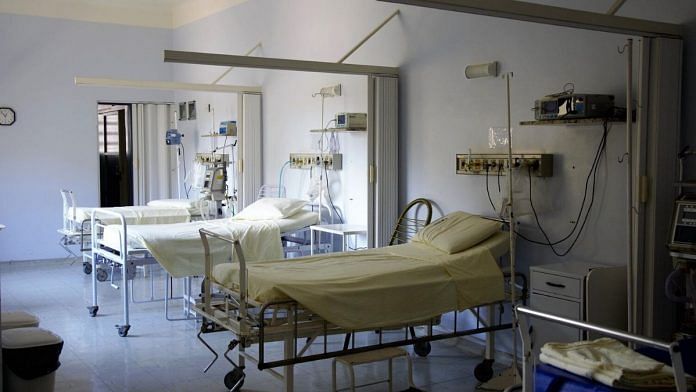New Delhi: A study by the Modi government has revealed grim tidings for India’s coronavirus battle. As many as 10 states and union territories face the risk of exhausting their ICU beds and ventilators, both crucial requirements for critical patients of Covid-19, in the coming weeks, the assessment suggests.
The study, accessed by ThePrint, claims the threat is immediate for Delhi, which it says may already have all its ICU beds occupied even as cases rise in the capital. However, Maharashtra, the worst-hit state, has time until August before its capacity is exhausted, according to the assessment.
The other states/UTs believed to be on this countdown are Uttar Pradesh, Gujarat, Jammu & Kashmir, Tamil Nadu, West Bengal, Haryana, Karnataka, Madhya Pradesh.
The Modi government assessment, which seeks to examine Covid-19 trends in India, was shared with states and union territories Thursday as they move ahead with plans to ease the lockdown. It factors in data until 9 June to derive ICU and ventilator projections for the days ahead, besides identifying nationwide trends for the pandemic’s progress.
Between June and August, the study says, Delhi, Maharashtra, West Bengal and Jammu & Kashmir, some of India’s worst-hit states and UTs, may run out of critical health infrastructure such as ICU beds and ventilators.
The government’s assessment is accompanied by an action plan where it has emphasised advance planning to meet the challenge looming on the horizon. The suggestions include developing hotels and stadiums as facilities for institutional quarantine, to keep the infection in check, and ensuring adequate human resources.
Also Read: High infection rate, low testing, tired doctors — KCR’s messy Covid battle in Telangana
Shortage predicted
Beds in the Intensive Care Units (ICU) of hospitals are required to treat patients who are critical, whereas a ventilator is used when the breathing centre of the brain is unable to control respiration. The machine resembles an octopus, with several pipes coming out of the main equipment, and is especially crucial amid the pandemic because Covid-19 is a respiratory disease.
The study suggests Maharashtra (with a projection of approx. 1.58 lakh), Tamil Nadu (1.01 lakh), Delhi (91,419), Haryana (39,781) and Gujarat (32,470) will account for the highest number of Covid-19 cases by 30 June.
Among these five states/UTs, Maharashtra has so far recorded 94,401 cases, Delhi 32,810, Haryana 5,579, Gujarat 21,521, and Tamil Nadu 38,841.
According to data listed in the assessment, Maharashtra currently has 8,045 ICU beds and 2,847 ventilators, while Delhi has 582 ICU beds and 468 ventilators. The number is 2,409 ICU beds and 2,125 ventilators for Gujarat, 4,064 ICU beds and 2,028 ventilators for Tamil Nadu, and 1,203 ICU beds and 546 ventilators for West Bengal.
Also Read: Why Delhi’s Covid patients are running from pillar to post in search of a hospital bed
Clock ticks
Delhi, the government’s projections suggest, would have run out of beds by 3 June, and is set to fall short of ventilators by 12 June. However, the Delhi government health bulletin issued Thursday evening said it had 584 “ICU/ventilators”, of which 266 are still vacant.
The survey says Maharashtra is likely to run out of ICU beds by 8 August, and ventilators by 27 July. For Tamil Nadu, the date is 9 July for both. The forecast for West Bengal suggests it will run out of ICU beds and ventilators by 29 July and 27 July, respectively.
The data shows Uttar Pradesh, Haryana, Karnataka, Jammu & Kashmir and Madhya Pradesh are also on the verge of exhausting their critical health infrastructure. The government has projected UP will run out of ICU beds by 1 August, while the date is 4 July for Haryana, 26 July for Karnataka, and 26 June for Jammu & Kashmir.
Haryana, Karnataka and J&K may exhaust their available ventilators by 4 July, 23 July, and 29 June, respectively, the study adds. Exact figures and projections were not given for Gujarat and Madhya Pradesh.
The government study states as many as 17 districts in seven states, including Haryana, Uttar Pradesh and Maharashtra, may experience capacity shortfall over the next one month, including bed shortages.
What next?
The action plan suggested by the government focuses on advance planning to mitigate the impact of the shortage and create alternative infrastructure.
It has asked states and union territories to ensure sufficient logistics (such as pulse oximeters), bed capacity and human resources (doctors, staff nurses, non-clinical staff).
The government has also emphasised the importance of institutional quarantine/isolation, saying it is increasingly critical to reduce the load on the healthcare system. In this light, the Modi government has suggested ramping up capacity by engaging hotels, stadiums etc.
The larger action plan to curtain infections includes strategies such as containment of disease through strict perimeter control, active house-to-house surveillance through special teams for early identification of cases, and community-led surveillance in highly affected districts.
The guidelines for “testing and tracing” focus on early testing of high-risk contacts in states and districts with a heavy case load, and clinical triaging (sorting patients on the basis of immediacy of treatment required) at facilities.
Preventive measures and active surveillance and testing have been advised, especially for vulnerable populations, with an objective of reducing “high-risk patient count and improving speed-to-care”.
This report has been updated with additional information
Also Read: Don’t deny treatment to CGHS beneficiaries, Modi govt tells hospitals, warns of action



